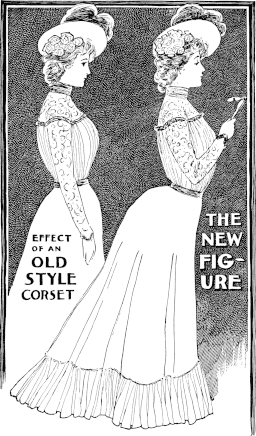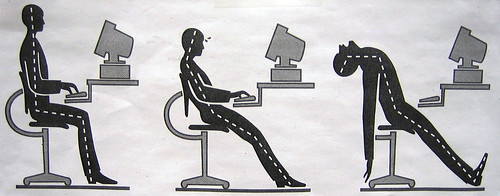Last Christmas my in-laws gave me a dress-form – one of those wire exoskeleton ones that you can shape to your own figure; or rather, have your dearly beloved shape to your figure, as it’s rather hard to achieve from inside the contraption.
Once I had been released, and the two halves appropriately wired together, we put it on the stand and took a look. Frankly, I was shocked. All right, I still had a waist, but when did my hips get so big? And my stomach? A look at the back of the form revealed the terrible truth: I was heading toward lordosis.
Not, as the name might suggest, a disease of delusive grandeur, but rather excessive inward curvature of the lower back. Basically, the tummy muscles go, and everything sags forward: stomach, spine, the lot. The opposite of this is kyphosis, where the upper back curves out too much and you get a hump.
Lordosis was all the rage in the Edwardian era – if you didn’t have it naturally, your corset would see to the ‘correction’ of your figure.
It is worth remembering, however, that this was over a hundred years ago and times have changed. Not only is a pigeon-breast considered unattractive on anything that doesn’t have wings, we also realize that having your lower back sag forward is Bad For You. (And so is being moulded by a corset. These days women are expected to turn their muscles into built-in shapewear.)
But what exactly is good posture?
According to the actress Shelley Long, “head up and shoulders back. Not only does it make you look taller and thinner but it gives you confidence and boosts your self-esteem.”
Presumably this applies to people of all shapes, sizes and genders. (Tall people: please stop slumping; this demographic is already taken.)
Very well then; head up (check!), shoulders back (check!), chest, er, up… and abdomen up and in. (Up where? Where I used to keep my chest?) Lower back flattened (but not flat), hips tilted back (as opposed to sagging forward), knees straight and feet parallel. That’s for standing. Sitting is another whole assortment of body parts.
But how does one achieve all this, without life becoming a ceaseless juggling of anatomical alignments? There’s always the old-fashioned finishing-school task of walking about the house with books balanced on one’s head (I’d advise against the Shorter Oxford unless you feel your neck is too long); or you can ask a helpful friend for the occasional reminder.
There are some simpler ways, though. One my mother taught me: grab hold of the hair at the crown of your head and pull firmly upward. It’s amazing how your spine will extend itself to relieve the pressure. And once your body knows the position, it’s easier to slide back into it.
But alas, if the problem is soft and saggy stomach muscles, there’s only one thing for it: exercise them until they’re tough enough to do their job.
Because bad posture isn’t just a bad habit, it’s a sign of problems down the road: back pain, neck pain, sagging here, slumping there… So heed your exoskeleton’s warning and change your posture before the problems come home to roost – or the pigeon breast comes back in.
NB: If you want your own exoskeleton, there’s a useful tutorial here. Bring duct tape.









